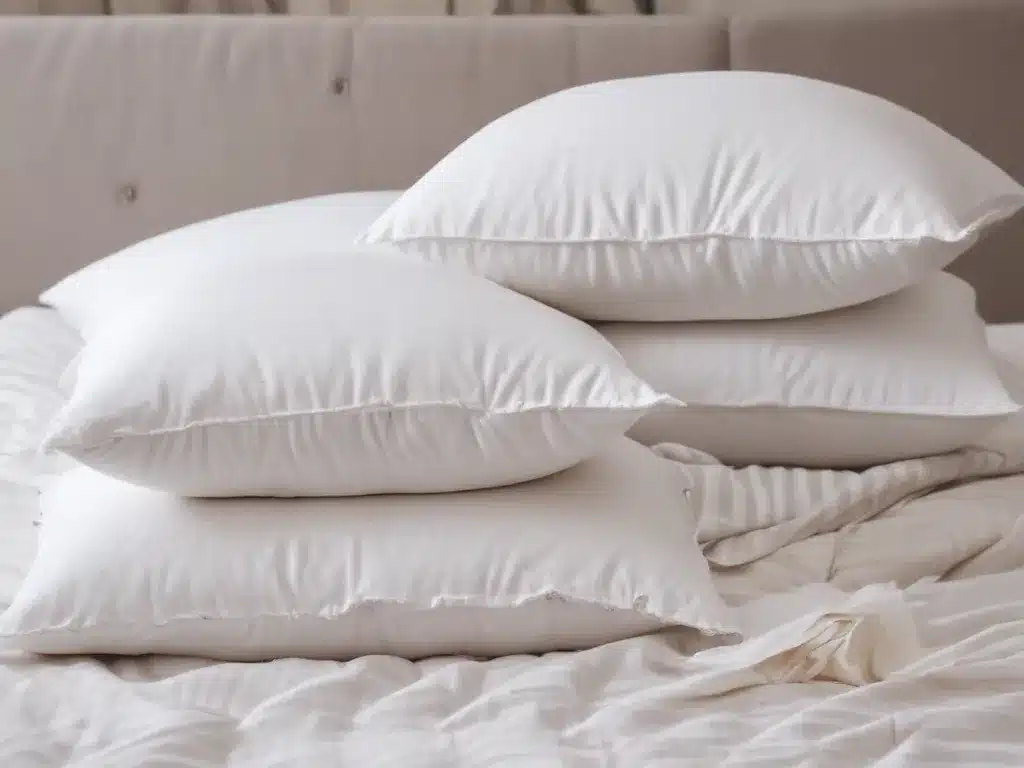Introduction
Pillows – the soft, fluffy companions that cradle our heads and necks during restful slumbers. However, over time, these cozy buddies can harbor a hidden menace – a buildup of allergens and bacteria that can wreak havoc on our health and well-being. Fear not, for I shall guide you through the intricate art of washing pillows, ensuring a fresh, clean, and allergen-free sleep sanctuary.
The Importance of Clean Pillows
Pillows play a crucial role in our sleep hygiene, and neglecting their cleanliness can have far-reaching consequences. Dust mites, a common household allergen, thrive in pillows, feeding on the dead skin cells and sweat that accumulate over time. Their presence can trigger allergic reactions, exacerbating respiratory issues like asthma and rhinitis. Additionally, bacteria and fungi can take up residence in pillows, potentially leading to skin irritations, acne, and other unpleasant conditions.
Beyond health concerns, dirty pillows can emit unpleasant odors and leave unsightly stains, diminishing the overall comfort and appeal of your sleeping environment. Regularly washing your pillows is a simple yet effective solution to maintain a hygienic and inviting sleep space.
Preparing for the Wash
Before diving into the washing process, it’s essential to gather the necessary tools and materials. You’ll need:
- A washing machine (or a large sink for hand-washing)
- Mild detergent specifically designed for pillows or delicate fabrics
- Fabric softener (optional)
- Tennis balls or dryer balls (for fluffing up pillows in the dryer)
Consult the care label on your pillows to determine the recommended washing method and temperature settings. If the label is missing or faded, err on the side of caution and opt for a gentle cycle with cool water.
Washing Pillows in the Machine
Follow these steps for a thorough and effective machine wash:
-
Remove Pillow Covers: Start by removing any pillowcases or protectors from your pillows. These should be washed separately.
-
Check for Stains: Inspect your pillows for any visible stains or heavily soiled areas. Pretreat these spots with a mild stain remover or a paste made from baking soda and water.
-
Load the Washing Machine: Place your pillows in the washing machine, ensuring they have enough room to tumble freely. Overloading the machine can prevent proper cleaning and rinsing.
-
Add Detergent: Follow the manufacturer’s instructions for the appropriate amount of detergent. Opt for a mild, fragrance-free formula to avoid irritating sensitive skin or triggering allergies.
-
Select the Cycle: Choose a gentle or delicate cycle with cool or warm water, depending on the care instructions. Avoid using hot water, as it can cause pillows to become misshapen or clump up.
-
Start the Wash: Once the settings are adjusted, initiate the wash cycle.
-
Fluff and Dry: After the wash cycle is complete, transfer the pillows to the dryer. Add a few tennis balls or dryer balls to help fluff and reshape the pillows as they tumble. Use a low or air-dry setting to prevent excessive heat from damaging the filling.
Hand-Washing Pillows
For pillows that cannot be machine-washed or if you prefer a more gentle approach, hand-washing is an excellent alternative. Follow these steps:
-
Fill a Bathtub or Large Sink: Fill a bathtub or large sink with cool or lukewarm water, adding a small amount of mild detergent.
-
Submerge and Agitate: Gently submerge the pillows in the water, squeezing and kneading them to allow the suds to penetrate the filling.
-
Rinse Thoroughly: After a thorough soaking and agitation, drain the soapy water and refill the tub or sink with clean water. Rinse the pillows thoroughly, ensuring all traces of detergent are removed.
-
Squeeze and Air Dry: Once rinsed, gently squeeze the pillows to remove excess water, being careful not to twist or wring them excessively. Lay them flat or hang them to air dry, fluffing and reshaping them periodically.
Additional Tips and Considerations
-
Frequency: Aim to wash your pillows every three to six months, or more frequently if you or someone in your household suffers from allergies or respiratory issues.
-
Pillow Protectors: Consider using pillow protectors or pillow covers to extend the life of your pillows and minimize the buildup of allergens and bacteria between washes.
-
Feather and Down Pillows: Feather and down pillows require special care. Follow the manufacturer’s instructions and consider using a gentle detergent designed for delicate fabrics.
-
Memory Foam Pillows: Memory foam pillows often have specific washing instructions. Some may not be machine-washable, in which case spot cleaning or air drying may be recommended.
-
Replace When Necessary: If your pillows remain lumpy, misshapen, or emit an unpleasant odor after washing, it may be time to replace them. Pillows have a limited lifespan and should be replaced every one to two years for optimal hygiene and comfort.
Conclusion
Maintaining clean and allergen-free pillows is a simple yet crucial step in creating a healthy and comfortable sleep environment. By regularly washing your pillows using the appropriate techniques, you can bid farewell to dust mites, bacteria, and other unwanted guests, ensuring a restful and rejuvenating slumber. Embrace the power of freshly washed pillows and wake up feeling refreshed, energized, and allergy-free.







